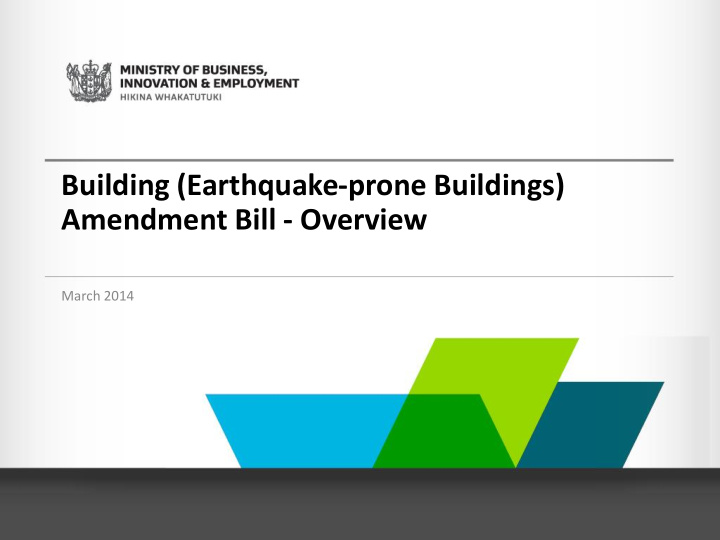



Building (Earthquake-prone Buildings) Amendment Bill - Overview March 2014
Introduction • Issue has been considered by the Canterbury Earthquakes Royal Commission • Comprehensive review also undertaken by the Government, including release of public consultation document and a range of public and stakeholder meetings held around New Zealand in 2013 • Requires balance to be struck between protecting people from harm in an earthquake and managing the costs of strengthening or removing buildings • Range of views reflected in public consultation. 535 submissions received on consultation document. More than 1,000 people attended public and stakeholder meetings
Introduction (continued) • Government’s decisions (reflected in the Bill) broadly in line with recommendations of the Royal Commission, but also take into account views of submitters received as part of the Government review • Introduces nationally consistent system for managing earthquake-prone buildings to ensure buildings are dealt with in a timely manner (local seismic risk is taken into account) • Provides for significantly greater role for central government to make better use of capability and resources of central and local government • Will ensure information about earthquake-prone buildings is made available to the public/market to inform decision making
Definition of earthquake-prone building (threshold) Current System System proposed in the Bill • • Defn in Act relates to performance of Clarifies current defn, including that a building in a ‘moderate earthquake’ the law applies to whole buildings or and life safety and other impacts of parts of buildings • collapse Fixes the defn of ‘moderate • Most residential buildings are earthquake’ to the design standard excluded at time of commencement • Local seismic risk taken into account in defn • In practice, defn is often referred to as less than 34% of the new building standard
Identification of earthquake-prone buildings Current System System proposed in the Bill • • Set in TA policies (approach can be Existing buildings to be assessed by active or passive) TAs in 5 years using a methodology set by the Ministry – priority buildings (defined in regulations) to be fast-tracked
Notification/Disclosure Current System System proposed in the Bill • • Section 124 notices attached to Seismic work notices (equivalent to earthquake-prone buildings and s124 notices) attached to copies provided to owners and earthquake-prone buildings and occupiers copies provided to owners and • Some TAs have a publicly searchable occupiers • register National Seismic Capacity Register – held by the Ministry and publicly searchable
Remediation level Current System System proposed in the Bill • • ‘Reduce or remove the danger’ level Clarifies remediation work required is of remediation in s124 – confirmed to the level to ensure that the to be 34% of the requirements for a building is no longer earthquake- new building in 2013 High Court prone decision of Insurance Council of New Zealand Inc v Christchurch City Council
Timeframes for remediation Current System System proposed in the Bill • • Timeframes determined in TA Remediation within 15 years of policies assessment • TA powers to set shorter timeframe for priority buildings (done in consultation with community) • Owners of Category 1 listed heritage buildings can apply to TA for extension of up to 10 years, but owners must manage risk
Exemptions from requirement to remediate Current System System proposed in the Bill • • Determined in TA policies Owners of certain earthquake-prone buildings can apply to TA for exemption from requirement to remediate • Specific exemption criteria to be defined in regulations – intention is to cover those buildings with low risk from failure
Other upgrades (means of escape from fire, access & facilities for people with disabilities) Current System System proposed in the Bill • • When undertaking earthquake Will enable TAs not to require strengthening, upgrades required to upgrades under certain ensure the building will comply ‘ as circumstances when earthquake nearly as is reasonably practicable’ strengthening is being undertaken on with the Building Code an earthquake-prone building
Offences and Enforcement Current System System proposed in the Bill • • Offence for an owner not to comply Restates existing offence and with a section 124 notice to enforcement provisions in Act and remediate their building, with a clarifies who they apply to • maximum fine of $200,000 Adds a new offence provision for • TAs also have powers to undertake owners who fail to display a seismic work directly and recover costs (work work notice or exemption notice taken can include demolition) (maximum fine of $20,000)
Transitional provisions in the Bill • Seeks to leverage off work already undertaken • Existing section 124 notices will continue where they have a timeframe of 15 years or less. Where the timeframe exceeds 15 years, existing section 124 notices are revoked. The TA must then reissue the notices using the particular provisions of the Bill • Assessments carried out before the Bill takes effect will be recognised provided they were carried out in a manner that is recognised in the methodology set by the Ministry
Next steps • First reading in Parliament completed, Local Government and Environment Select Committee calling for public submissions
Recommend
More recommend